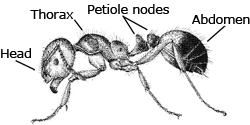By Michelle Ramsey, Butte County Master Gardener, June 14, 2013
We often experience ants in our homes when weather conditions change. They are typically looking for food, water, warmth, and/or protection from extreme weather conditions. Ants belong to the insect order Hymenoptera and are close relatives of bees and wasps. The most common outdoor ant found in California is the Argentine worker ant. The Argentine worker ant is approximately 3mm long, dark colored and does not sting. They have no natural enemies. Their colonies have multiple queens and only the queens lay eggs. An ant’s life cycle moves from egg to larva to pupa to adult. Their nests are normally found in moist soils, under debris or along sidewalks and driveways. Argentine ants are drawn to sweet foods but will also feed on protein (e.g. dead bugs). The Argentine ant will venture up to 100 feet away from the nest to find food, water and shelter inside buildings. Once inside, if ants find food, they will continue to invade until the food source is removed and/or the entryway sealed.
While it is not realistic to eradicate all ants from your backyard, you can effectively reduce the number of ants entering your home by following a 3-Step integrated approach as follows:
Minor Indoor Problem (small trail of ants observed infrequently). Prevent further intrusion by:
1) Identifying the location where the ants are getting into the house. Inspect baseboards, floors, electrical outlets, vents, pipes, drains and walls for any entryways and seal them off (caulk is good for this). Destroy any nesting sites found close to the house. Cut back trees, shrubs or wooded material touching the house and clear away mulch or debris that is next to the house.
2) Clean up food and water sources in the home. All sources of “attractive” food should be removed or securely sealed. Use soapy water to kill ants and eliminate their trails.
Moderate (trails of hundreds of ants) and severe (several hundred to thousands of ants continue to invade for weeks or months). Supplement steps 1 and 2 above with the addition of bait stations as follows:
3) Install bait dispensers around the outside of the house (UC Researchers have had success using bait dispensers such as KM AntPro Liquid Bait Dispenser). Baits are more effective and less toxic than traditional pesticide treatments for ants. Baits are insecticides mixed with materials that attract worker ants. The advantage of a bait station over an insecticide spray is that the spray only kills the worker ant while the bait station allows worker ants to take the bait back to the colony to feed and kill the colony ants, including the queen ant. When all the queens die, the colony is destroyed. Continue to refill dispensers regularly with liquid borate-based bait until the ant problem ceases. It is critical that you select the right bait/attractant for Argentine ants (liquid baits with 1% or less borate are suggested). Install at least one dispenser on each side of the house, next to structures where ants are trailing (but at least 5 ft. from any nest). Keep ant bait stations out of direct sunlight.
Following the 3-step approach above should correct home ant invasions.
For more information visit:
http://www.ipm.ucdavis.edu/PMG/PESTNOTES/pn7411.html
